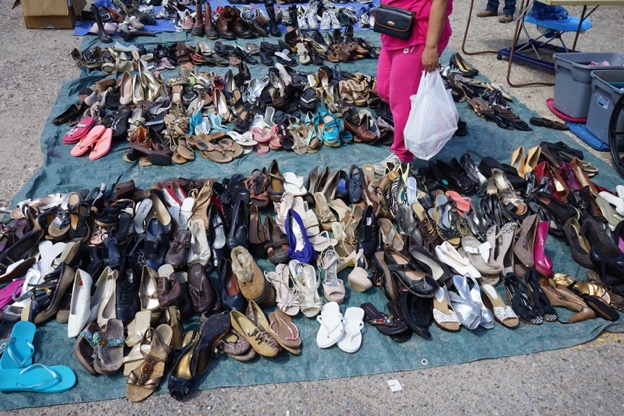I spent the night in McAllen, Texas, at the home of a retired couple from Minnesota. Bob Schwartz and Janet Schwaab aren’t bikers, themselves, but they signed up for Warm Showers, a hospitality network for long-distance cyclists, because it seemed like the nice thing to do. Like thousands of other snowbirds in Arizona, Texas, and Florida, Bob and Janet head south every winter. This year has been especially cold, but typically by April everyone from their +55 community has returned home. Which is probably for the best. Between all the dinners, dances, bingo, and booze, Bob and Janet are having more fun with their friends than couples a third of their age. They found each other lonely and heartbroken after losing their long-time spouses, and they got married two years ago. “I was married to a minister,” Janet said to me quietly in her Yankee accent, “but this right here,” jerking a thumb in Bob’s direction, “is a whole different ball game.”
You’d never guess that their gated neighborhood, with its nicely proportioned single-level homes, well-tended yards, and slow-moving golf cart traffic could be so close to the U.S.-Mexico border. The fighting between the cartels has calmed down significantly throughout Mexico, and there are fewer people crossing the border illegally every year, but this region is an exception to both trends. The cities of Reynosa, across the river from McAllen, and Matamoros, south of Brownsville, continue to see high levels of violence. Only in the Rio Grande Valley have apprehensions increased between 2000 and 2016, as USA Today showed in an analysis of nine border crossings. There were 186,830 there in 2016, according to Department of Homeland Security data, up nearly 40,000 from 2015. In every border town I’ve visited, Americans cross into Mexico regularly to go shopping, get their hair cut, or visit the dentist. But nobody crosses the border here unless they have to.
I waved goodbye to Bob and Janet and set off for Brownsville 60 miles east. US 83, the so-called “Road to Nowhere,” has grown from a rural two-lane road to a bustling six-lane expressway with overpasses and exit ramps. Lush suburban neighborhoods sit across the road from productive warehouses and shipping centers. Mega-sized billboards push above the palm trees, justifying McAllen’s nickname “the city of palms.” Green lawns are typically an indulgence along the border, but grass grows easily in this tropical environment next to wild marijuana plants. There’s a Texas grocery store chain called HEB, which I’ve learned means Here Everything’s Better, and in McAllen the name rings true. The weather was perfect for biking, overcast and in the 70s. Only a column of sinister black smoke on the horizon reminded me of the war zone just across the river.
I turned south off US 83 and pedaled through the small city of Hidalgo to the port of entry. The Rio Grande turns endlessly to and fro and doubles back on itself, and just outside the border crossing is an outdoor market tucked in on three sides by the border fence. Practically in the shadow of the barrier, within the parameters of a second chain link fence, hundreds of people are selling shoes, golf clubs, sneakers, used electronic equipment, rollerblades, and perfume from under the shade of huge tarps whipping in the wind. Shoppers of all ages wander the stalls, sorting through the massive, unorganized piles of the second-hand stuff; there’s no other word for it.

Several shoppers came up to compliment me (at least I think) on my now filthy Mexican flag bike jersey. I did what I always do in these situations—smile, nod, and declare “no hablo espanol”—which never ever seems to dampen anyone’s interest in chatting. If I were just across the border that kind of attention might get me kidnapped or killed.
Several days ago I met a woman who had grown up in Reynosa (we’ll call her Julia). She still has family in Mexico, but she says she wouldn’t dare go back to her home town because of the cartel violence. She’s already been caught in the middle of three different shootings and doesn’t want to push her luck.
“It was in my parents’ apartment,” Julia told me, “and we just laid down. You could see because [the building] is brick the bullets and the bombs going off and everybody screaming, everybody taking cover. We lived across from a school but they [the mafia] don’t care, they just start shooting.”
The police in Reynosa have been replaced by the military, but soldiers are also liable to be on the cartel payroll—take the case of eight Mexican soldiers who were sentenced last year for collaborating with members of the Los Zetas cartel. Unable to trust the government, people have turned to Facebook. Julia showed me a public group called “Reynosa Codigo Rojo” (Reynosa Code Red) where individual citizens warn each other of ongoing shootings and incidents not reported by the media, which, of course, is also controlled by the cartel.
“How do people in McAllen and Brownsville feel about Mexico?” I asked.
“Don’t go there!” Julia shouted at me with a laugh. Like, duh.
In Reynosa, despite the heat, she would drive with the AC off and the windows down so that she could listen for gun shots. If she saw people running or anyone holding a weapon, she would run for cover in the nearest building.
The cartel in this section of the border often kidnaps boys as young as 14 and forces them to work as foot soldiers. “I got a couple of nephews,” Julia told me, “they are already gone. Disappeared.” She says what’s really sick is that the drug lords live in the posh sections of McAllen, safely away from the violence they’ve created. Their kids go to school on the American side; they say to the teachers, “if you give me a bad grade my dad is gonna come and get you,” says Julia.

